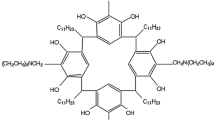Abstract
In this work optically active cavitand – based thin films purposely produced for detecting aromatic compounds at very low concentrations (ppb) has beeen used as optical sensing materials for benzene monitoring.
Access this chapter
Tax calculation will be finalised at checkout
Purchases are for personal use only
Similar content being viewed by others
References
Pirondini L, Dalcanale E (2007) Molecular recognition at the gas-solid interface: a powerful tool for chemical sensing. Chem Soc Rev 36:695–706
Soncini P, Bonsignore S, Dalcanale E, Ugozzoli F (1992) Cavitands as versatile molecular receptors. J Org Chem 57:4608–4612
Tonezzer M, Quaranta A, Maggioni G, Carturan S, Della Mea G (2007) Optical sensing responses of tetraphenyl porphyrins toward alcohol vapours: a comparison between vacuum evaporated and spin-coated thin films. Sens Actuators B 122:620–626
Tonezzer M, Melegari M, Maggioni G, Milan R, Della Mea G (2008) Vacuum-evaporated cavitand sensors: dissecting specific from nonspecific interactions in ethanol detection. Chem Mater 20:6535–6542
Acknowledgments
The research leading to these results has received funding from CARITRO and from the European Community's Seventh Framework Programme FP7/2007–2013 under grant Agreement Marie Curie 7th Framework Program – PCOFUND-GA-2008-226070, acronomy “ProgettoTrentino” within PHOTOFUTURE project.
Author information
Authors and Affiliations
Editor information
Editors and Affiliations
Rights and permissions
Copyright information
© 2014 Springer Science+Business Media New York
About this paper
Cite this paper
Tonezzer, M. et al. (2014). Luminescent Cavitands as Novel Optically Active Materials. In: Baldini, F., et al. Sensors. Lecture Notes in Electrical Engineering, vol 162. Springer, New York, NY. https://doi.org/10.1007/978-1-4614-3860-1_73
Download citation
DOI: https://doi.org/10.1007/978-1-4614-3860-1_73
Published:
Publisher Name: Springer, New York, NY
Print ISBN: 978-1-4614-3859-5
Online ISBN: 978-1-4614-3860-1
eBook Packages: EngineeringEngineering (R0)




